Orlando International Airport is a major public airport located 6 miles (10 km) southeast of Downtown Orlando, Florida. In 2019, it handled 50,613,072 passengers, making it the busiest airport in the state and tenth busiest airport in the United States.
The airport is also a major international gateway for the mid-Florida region, with over 850 daily flights on 44 airlines. The airport also serves 135 domestic and international destinations. At 12,600 acres (5,100 ha / 51 km² ), MCO is one of the largest commercial airports in terms of land area in the United States.In addition, the airport is home to a maintenance base for United Airlines.
The airport code MCO stands for the airport’s former name, McCoy Air Force Base, a Strategic Air Command (SAC) installation, that was closed in 1975 as part of a general military drawdown following the end of the Vietnam War.
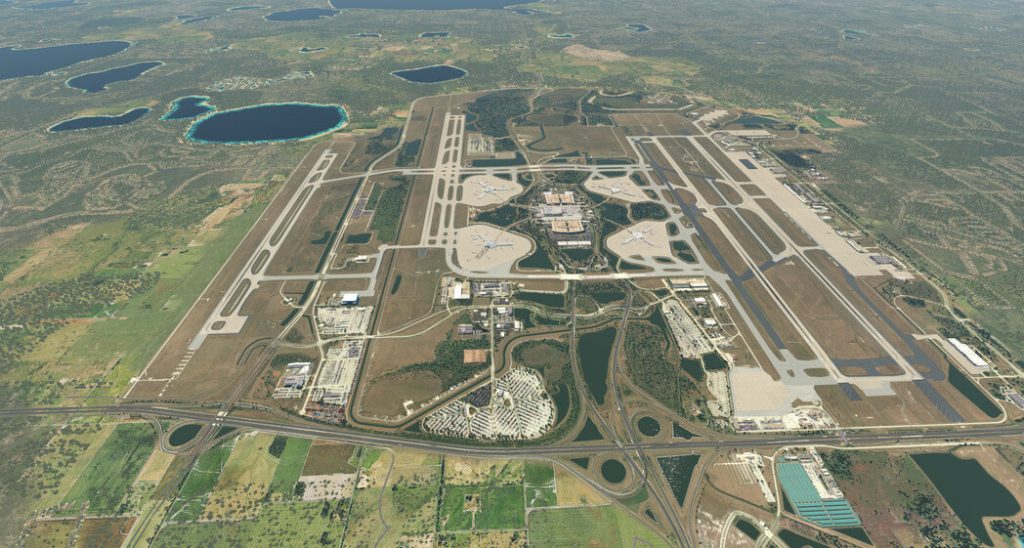
History
Military years
The airfield was originally constructed as a U.S. Army Air Forces facility and military operations began in 1942 as Orlando Army Air Field #2,.
Orlando Army Air Field #2 was renamed Pinecastle Army Airfield in January 1943.
In the 1950s, the base began hosting SAC’s annual Bombing and Navigation Competition.
During the Cuban Missile Crisis in October 1962, McCoy AFB became a temporary forward operating base for more than 120 F-100 Super Sabre and F-105 Thunderchief fighter bombers and the primary base for U-2 reconnaissance aircraft flying over Cuba.
McCoy AFB was identified for closure in early 1973 as part of a post-Vietnam reduction in force.
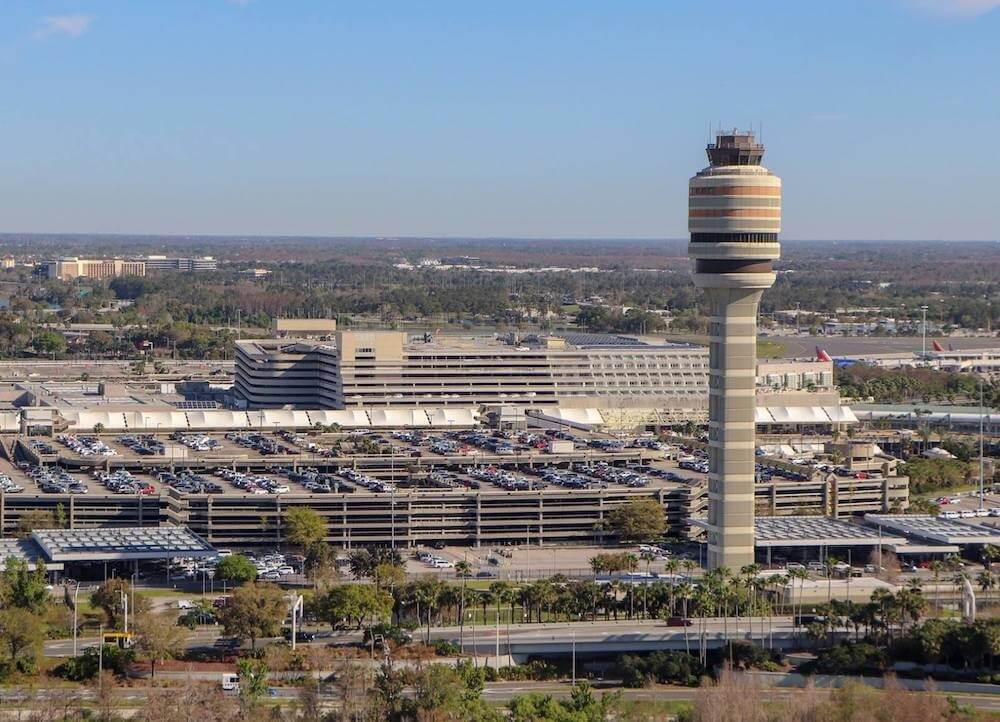
Civil-military years
In the early 1960s, when jet airline flights came to Orlando, the installation became a joint civil-military facility.
Airline flights to the Orlando Jetport began shortly after an agreement was signed by the city and USAF in October 1961
When McCoy AFB closed in 1975, part of the facility stayed under military control to support Naval Training Center Orlando and several tenant commands.
Civil years
In 1975, the final Air Force contingent departed McCoy AFB and the Greater Orlando Aviation Authority (GOAA) was established as a state-chartered local governmental agency and an enterprise fund of the city of Orlando.
In 1978, construction of the current Landside Terminal and Airsides 1 and 3 began, opening in 1981.
The original International Concourse was housed in Airside 1 and opened in 1984. Funding to commence developing the east side of the airport was bonded in 1986, with Runway 17/35 (now 17R/35L) completed in 1989.
Airside 4 opened in 1990 and also contains an International Concourse for the processing of international flights. Airside 2, which filled out what will become known as the North Terminal complex, was completed in 2000, with the last additional gates added in 2006. Runway 17L/35R was opened in 2003, providing the airport with a total of four runways.
In 1978, the airport handled 5 million passengers. By 2018, that number had risen to 47 million.
Today it covers 51 square kilometers (19.7 sq mi) and is the fifth-largest airport in the United States by land area after Denver International Airport which covers 136 square kilometers (52.4 sq mi), Dallas/Fort Worth International Airport which covers 70 square kilometers (26.9 sq mi), Southwest Florida International Airport which covers 55 square kilometers (21.2 sq mi), and Washington Dulles International Airport which covers 53 square kilometers (20.3 sq mi).
MCO has North America’s fourth tallest control tower at 345 feet, replacing two earlier Air Force and FAA control towers.
Orlando was a designated Space Shuttle emergency landing site.
The west-side runways, Runway 18L/36R and Runway 18R/36L, were designed for B-52 Stratofortress bombers and due to their proximity to NASA’s John F. Kennedy Space Center, were an obvious choice for an emergency landing should an emergency return to launch site (RTLS) attempt to land at KSC have fallen short.

The runway was also an emergency divert site for NASA’s Boeing 747 Shuttle Transport Aircraft when relocating orbiters from either west coast modification work or divert recoveries at Edwards AFB, California or the White Sands Missile Range, New Mexico.
In October 2006, a 100-space Cell Phone Parking Lot for drivers to use while waiting for passengers to arrive was opened. The lot is set up as a free Wi-Fi Hotspot, enabling drivers to use their mobile devices to access the Internet, check e-mail, and monitor flight status.
By the end of 2015, the airport handled 38.8 million passengers, surpassing its previous record of 36.4 million in 2007. In 2017, the airport reached 44.6 million passengers, surpassing Miami International Airport to be become the busiest airport in the state of Florida.
Terminals and concourses
The Orlando International Airport has a hub-and-spoke layout with a large main terminal building and four airside concourses accessible via elevated people movers, with a total of 129 gates.
The main terminal building is divided into two terminals; Terminal A (on the building’s north side) and Terminal B (on the building’s south side).
The airport features an on-site Hyatt Regency hotel within the main terminal structure. The hotel is located on the East Atrium side of the terminal with a fourth floor lobby level and guest rooms beginning on level five and above.
The airport features an expansive lobby area for guests awaiting flights, convention space, several bars, and two restaurants including a signature restaurant on the top level of the terminal building overlooking the airport facility and runways below.
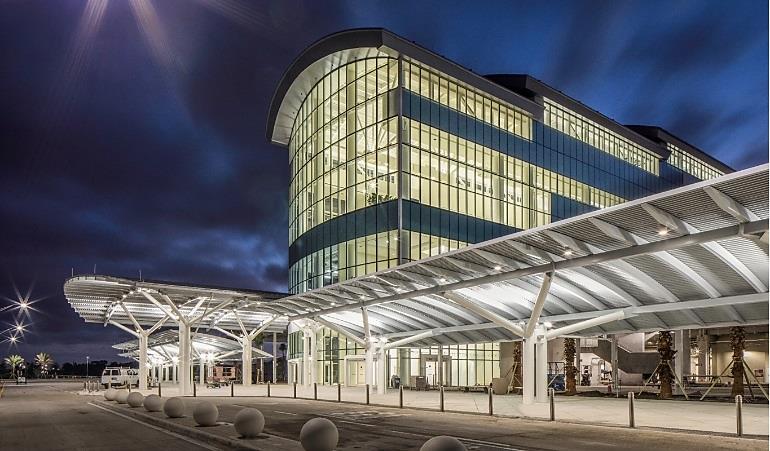
Terminal A
Terminal A consists of the northern half of the main terminal, with tramway systems to Airside 1 and Airside 2. Airlines operating check-in and baggage facilities within Terminal A generally operate out of Airside 1 and Airside 2, but that is not always the case.
Airside 1
- Gates 1–29
- Secondary International Arrivals Concourse
- Part of original terminal, opened in 1981
- Airlines operating scheduled flights from Airside 1: Aeroméxico, Avianca, Azul, Copa Airlines, Frontier, JetBlue, Silver Airways
- Charter airlines operating from Airside 1: Magnicharters, XTRA Airways, World Atlantic Airways
- Gates 20, 22-28 are capable of handling international arrivals.
- The Club at MCO
Airside 2
- Gates 100–129
- Airlines operating scheduled flights from Airside 2: Alaska Airlines and Southwest
Terminal B
United Airlines at Gate 41 getting ready to depart to Newark Liberty International Airport
Terminal B consists of the southern half of the main terminal, with tramway systems to Airside 3 and Airside 4.
Airlines operating check-in and baggage facilities within Terminal B generally operate out of Airside 3 and Airside 4, but that is not always the case.
Airside 4 also houses the primary international arrivals concourse used by many European airlines.
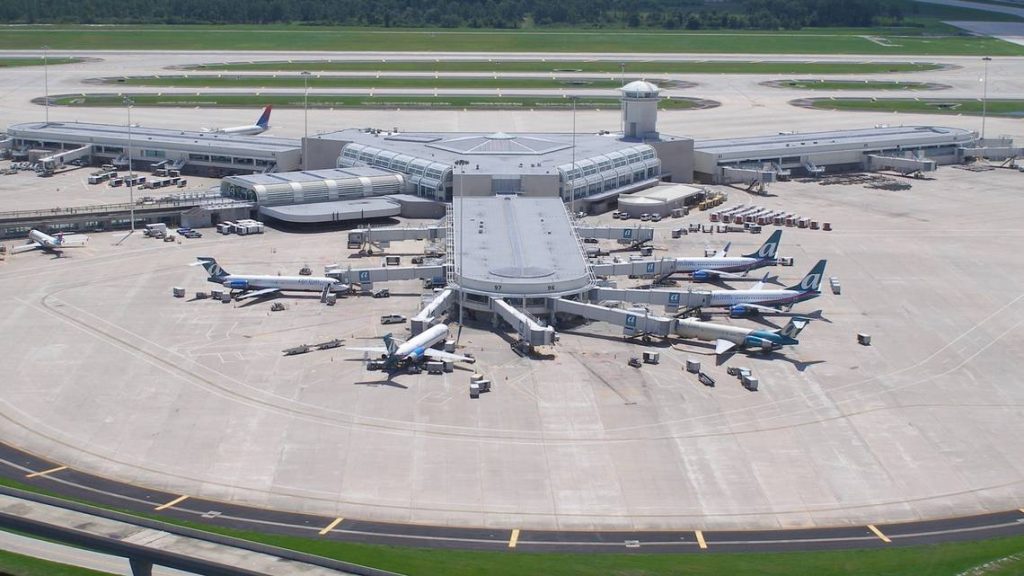
Airside 3
- Gates 30–59
- American Airlines Admirals Club
- United Airlines United Club
- Part of original terminal, opened in 1981
- Airlines operating scheduled flights from Airside 3: American, Spirit and United
Airside 4
- Gates 70–99
- Primary International Arrivals Concourse
- The Club at MCO
- Delta Air Lines Sky Club
- Airlines operating scheduled flights from Airside 4: Aer Lingus, Air Canada, Air Canada Rouge, Air Transat, Bahamasair, British Airways, Caribbean Airlines, Delta, Edelweiss, Emirates, Icelandair, LATAM, Lufthansa, Norwegian Long Haul, Sun Country, Sunwing Airlines, Swoop, Virgin Atlantic, Volaris and WestJet
- Gates 80-87 are capable of handling international arrivals, and gates 92, 94, and 96 are nearing completion to be used as “swing” gates. Gate 90 was updated in the summer of 2018 to be able to handle the Airbus A380, having two airbridges for the lower deck (gates 90A and 90B), and one airbridge for the upper deck (gate 90C). This is despite the lack of a regular A380 operator as of March 2020
Terminal expansions and renovations
Airside terminals 1 and 3, both of which opened in 1981, recently underwent major renovations designed by architects C.T. Hsu + Associates.
The new terminal designs incorporate modern architectural features that includes new skylights and expanded concession areas. In addition, the mechanical and electrical systems were completely overhauled in each terminal.
The General Contractor was Hensel Phelps Construction Co. for both Airside 1 and 3. The project was completed in both terminals in 2010. In 2012, British Airways announced the opening of a ‘shared lounge’ in Airside 4.
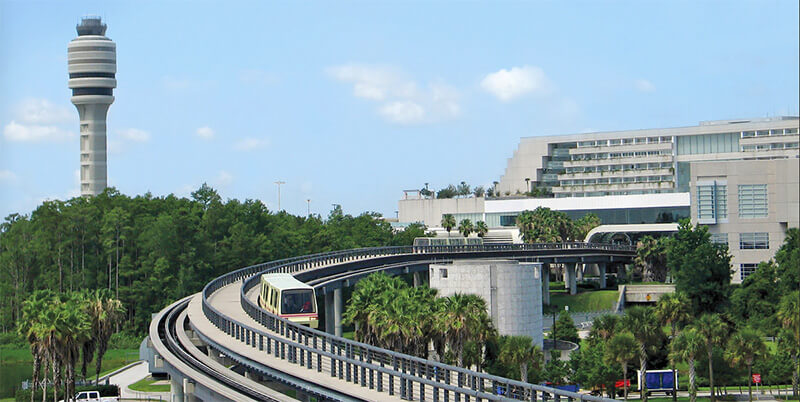
South Airport Intermodal Terminal
The South Airport Intermodal Terminal is currently under construction approximately one mile due south of the main airport terminal.
The new station, which is partially being funded by the Florida Department of Transportation, will serve as the Orlando station for the Virgin Trains USA higher speed regional rail service to South Florida, possibly Sunrail, and a link to International Drive. The station, which will be connected to the main terminal via an automated people mover (APM) system, is mostly reusing plans from the original Florida High Speed Rail Orlando Airport station, which would have been northern terminus of the initial Orlando-Tampa route along the Interstate 4 corridor, a project that was killed.
As part of the estimated $684 million price tag for the intermodal terminal complex, the airport authority is building a new 2,500 space parking garage.
A future connection to the SunRail commuter rail service is also being explored. The route to the current SunRail line would travel along a Orlando Utilities Commission rail spur, before either branching off to the intermodal station, or have an intermediate transfer point on to light rail to complete the journey to this station.
Multiple options are being considered for the link to I-Drive, either an elevated maglev train system built by American Maglev Technology, connecting the airport to the Orange County Convention Center, the Florida Mall, and the Sand Lake Road SunRail station, or a light rail link running along a similar route as the maglev alternative between the airport and International Drive.
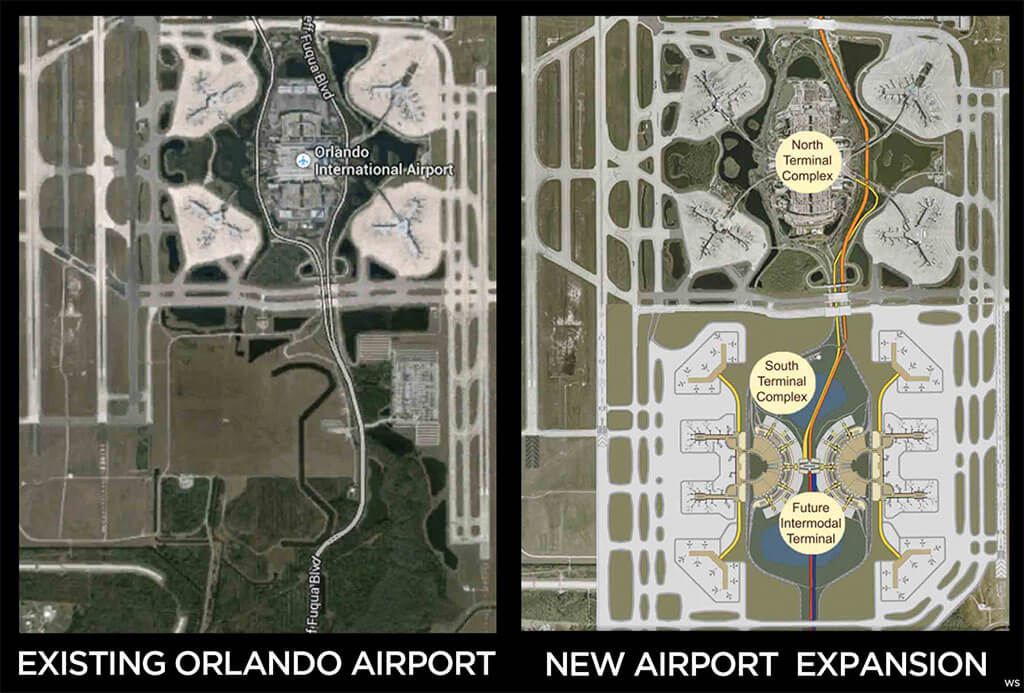
South Terminal Complex
In May 2015, the Board of the Greater Orlando Aviation Authority (GOAA) voted unanimously to approve construction of the $1.8 billion South Terminal Complex (STC), which will be located directly south of the existing terminal.
The STC will be built adjacent to the South Airport Intermodal Terminal, which was completed in early 2018, and both will be connected to the existing terminal via a new Automated People Mover (APM).
Phase I (which will be known as “Terminal C”) will encompass approximately 300 acres (120 ha) and will include new aircraft taxiways and aprons, a 2.7-million-square-foot (250,000 m2) terminal building with 16-24 gates, and a 6-story 5,000 space parking garage.
Construction of the STC began in 2017, and it is expected to be operational by 2021.
In June 2018 GOAA approved the expansion of Phase 1, known as Phase 1X, which will add another six gates to the South.
The construction firms building the new South Terminal are Hensel Phelps (airside), and Turner-Kiewit Joint Venture (landside). Vanderlande Industries will be providing the new high-tech ICS haggage handling system.
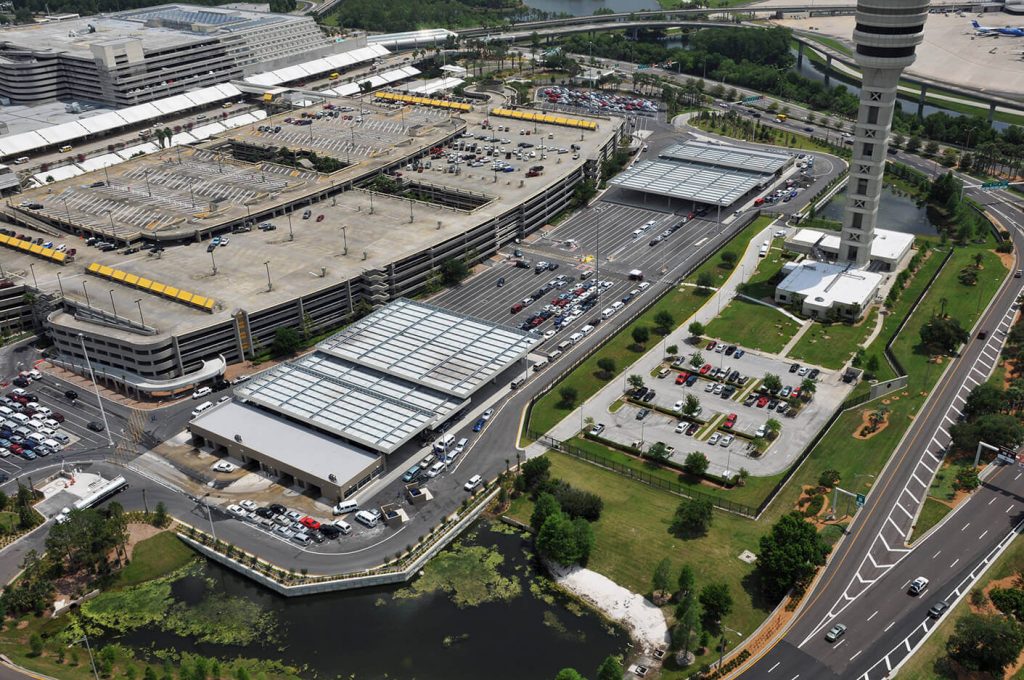
Orlando International Airport Data
- Country
- America
- Region
- North America
- Status
- In use
- Location
- Orlando, Florida, U.S.
- Owner(s)
- Greater Orlando Aviation Authority
- Official website
- orlandoairports.net
- Operator(s)
- Greater Orlando Aviation Authority
- Began
- 1942
- Opened
- 1981
- Airport type
- Public
- Airport code
- IATA:MCO,ICAO:KMCO,FAA LID:MCO
- Airport area
- 12602 acres / 51 km²
- Runway length
- 2*3659 m,1*3048 m,1*2743 m
- Passenger traffic
- 50.6 million(2019)
- Freight volume
- 228,521 tons (2019)
- Takeoffs and landings
- 357,689 sorties (2019)
View Orlando International Airport on Google Satellite Map
Google satellite maps allow you to see building details more clearly, including natural landscapes such as mountains, rivers, deserts, sea and man-made engineering buildings.
If you are very interested in this engineering building, it is a good idea to click below Google Map icon. We will help you jump to the corresponding location of this building or engineering on Google satellite map.





























































